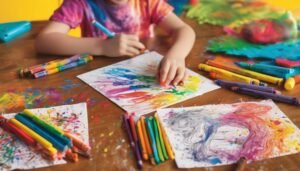When it comes to coloring techniques for children ages 3 to 6, you’ll find that the right approach can significantly enhance their creativity and fine motor skills. Using crayons and markers offers unique benefits, while introducing watercolor can spark their imagination in new ways. Balancing structured activities with free drawing allows kids to express themselves fully. But what’s the best way to mix these techniques for maximum impact? Let’s explore further.
Key Takeaways
- Encourage the use of crayons for layering colors and developing fine motor skills through gripping and applying pressure.
- Introduce markers for vibrant blending and sharp lines, allowing children to experiment with different textures and effects.
- Utilize watercolor techniques like wet on wet and layering to enhance creativity and teach color transparency.
- Balance coloring books for structured practice with free drawing to foster imagination and self-expression.
- Incorporate themes and stories into coloring sessions to engage language skills and spark creativity through narrative connections.
Benefits of Coloring for Young Children
Coloring isn’t just a fun activity for young children; it offers a wealth of benefits that contribute to their overall development. Engaging in coloring helps enhance cognitive development as kids learn to recognize colors, shapes, and patterns. This process stimulates their imagination and encourages problem-solving skills, essential for their growth.
Additionally, coloring significantly boosts fine motor skills. As they grip crayons or markers, children develop hand-eye coordination and dexterity, crucial for tasks like writing and self-care later on.
You’ll notice how their confidence grows as they master these skills. So, when your little one colors, remember it’s not just about creating a picture; it’s about nurturing their development in a joyful and creative way.
Crayons and Markers: Exploring Textures
As your child explores the world of coloring, the choice of tools can make a big difference in their experience. Crayons and markers each offer unique textures that can enhance creativity. Encourage your little one to experiment with different crayon techniques, like layering colors or using the side of the crayon for broader strokes. Markers, on the other hand, allow for fun marker blending, creating beautiful gradients and shades.
Here’s a quick guide to help you:
| Tool | Texture | Technique |
|---|---|---|
| Crayons | Smooth, waxy | Layering colors |
| Markers | Fluid, vibrant | Blending colors |
| Crayons | Rough, textured | Scribbling for depth |
| Markers | Sharp, defined lines | Dabbing for effects |
Let your child enjoy the journey!
Watercolor Techniques for Creative Expression
When introducing your child to watercolors, you’ll discover a world of creative possibilities that invites exploration and experimentation.
Watercolors are perfect for young artists, offering a unique chance to play with colors and textures.
Here are some fun techniques to try:
- Wet on wet: Start with a wet brush on damp paper, allowing colors to blend and swirl beautifully.
- Salt texture: Sprinkle salt on wet paint to create interesting textures as it dries, revealing unique patterns.
- Layering: Encourage your child to layer colors, teaching them about transparency and depth.
- Brush variety: Use different brushes—like sponges or fan brushes—to create diverse strokes and effects.
These techniques not only foster creativity but also enhance fine motor skills and color recognition.
Enjoy the process together!
Coloring Books vs. Free Drawing
While both coloring books and free drawing offer valuable opportunities for artistic expression, each approach has its unique benefits that cater to different aspects of a child’s development.
Coloring books provide structure and help children develop their coloring preferences, encouraging focus on staying within lines and choosing colors thoughtfully. This can enhance fine motor skills and color recognition.
On the other hand, free drawing grants kids artistic freedom, allowing them to explore their imagination without constraints. They can create whatever comes to mind, fostering creativity and self-expression.
Balancing both methods can be incredibly beneficial; you can encourage your child to enjoy the guided experience of coloring books while also giving them the space to unleash their creativity through free drawing.
Incorporating Themes and Stories Into Coloring
How can you make coloring even more engaging for your child? By incorporating themes and stories into their coloring activities, you can spark their imagination and enhance their creativity.
Themed coloring not only makes the experience fun but also helps with story integration, allowing your child to connect art with narrative.
- Choose a favorite story or character to inspire the coloring session.
- Create a simple storyline for them to follow while they color.
- Use themed coloring pages that relate to their interests—think animals, space, or fairytales.
- Encourage them to narrate their story as they color, fostering language skills and creativity.
This approach makes coloring not just an art activity, but an exciting adventure!
Group Coloring Activities for Social Skills
Group coloring activities are a fantastic way for kids to build social skills while having fun together.
When you encourage them to share coloring supplies and collaborate on artwork projects, they learn the value of teamwork and communication.
These experiences not only boost their creativity but also foster important friendships that can last a lifetime.
Sharing Coloring Supplies
Sharing coloring supplies during group activities can be a fantastic way for young children to develop their social skills. By encouraging kids to collaborate, you help them learn important sharing techniques.
Here are some ways to make sharing fun and engaging:
- Set up a communal coloring area: Create a space where everyone can easily access supplies.
- Introduce turn-taking: Teach children to wait for their turn when using popular coloring tools.
- Encourage teamwork: Have kids work together on a coloring page, fostering communication and cooperation.
- Praise sharing efforts: Recognize and celebrate moments when children share or help each other.
These activities not only make coloring enjoyable but also lay the groundwork for positive social interactions as they grow.
Collaborative Artwork Projects
While coloring alone can be enjoyable, collaborating on artwork projects offers young children an exciting opportunity to build social skills and creativity.
Engaging in group coloring activities allows kids to communicate their ideas, share responsibilities, and develop teamwork. As they work together to create joint masterpieces, they’ll learn to appreciate different perspectives and styles.
Encourage them to discuss colors, shapes, and themes, fostering a sense of community creativity. This interaction not only enhances their artistic expression but also nurtures empathy and cooperation.
Celebrate their finished pieces as a group, reinforcing the value of collaboration. By participating in these projects, your little ones will cultivate essential social skills while having a blast creating art together!
Frequently Asked Questions
What Age Should Children Start Using Coloring Tools?
You can introduce coloring tools around 18 months, as children hit key developmental milestones. Observe their fine motor skills and interest, then select age-appropriate coloring tools that encourage creativity and engagement in this exciting phase.
How Can I Encourage My Child to Color More?
To encourage your child to color more, try incorporating fun coloring games and creative prompts. Set up a cozy space, offer vibrant materials, and celebrate their creations to inspire ongoing artistic expression and enjoyment.
Are There Specific Colors That Aid in Mood Improvement?
Yes, certain colors can boost mood! For instance, yellows evoke happiness, while blues promote calm. Understanding color psychology and its associations helps you choose hues that uplift your child’s spirits during their creative time.
How Do I Store My Child’s Coloring Supplies?
Did you know that organized spaces can boost creativity by 30%? To store your child’s coloring supplies, use labeled bins or drawer organizers. This way, you’ll keep everything tidy and make art time more enjoyable!
What Should I Do if My Child Prefers Not to Color?
If your child prefers not to color, encourage alternative activities like drawing, crafting, or playdough. These can foster creative expression, letting them explore their imagination in different ways while still enjoying art. Keep it fun!
Conclusion
As you guide your little artists through the colorful world of creativity, remember that each stroke of crayon or splash of watercolor is a step on a vibrant journey. By mixing structured coloring with the freedom of imagination, you’re nurturing not just their fine motor skills but their ability to dream big. So, let their creativity soar like kites in the sky, and watch as they paint their own unique stories with every vivid hue.




